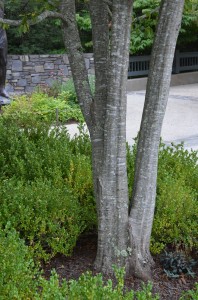Underutilized and underappreciated. That’s American hornbeam (Carpinus caroliniana), aka ironwood or muscle wood. It grows primarily in moist, slightly acid soils along woodland rivers and streams. Our native hornbeam possesses the ability to adapt to a range of landscape situations. It grows equally well in full sun or partial shade.
Its dark green summer foliage is rarely troubled by disease or pest problems. Its autumn foliage turns intense shades of yellow, orange and scarlet, depending on soil pH and the provenance of the species. It tolerates either wet or dry soils, but should provide adequate drainage. Hornbeam copes with urban conditions better than most. It survives in tough environs such as non-irrigated planting islands in parking lots. Contrarily, it’s an ideal choice for planting in rain gardens.
Ironwood blooms in spring, with separate male and female catkins. While the male catkins are not particularly showy, the female catkins form unique clusters of winged nutlets that are clearly visible in the fall. The nutlets provide mast for numerous forest fauna. Its grayish fluted bark gives the trunk and branches a muscular feature which is easily identifiable in the winter woods.
Hornbeam grows 20 to 35 feet tall and nearly as wide. The tree often grow multi-stemmed. With clean summer foliage, interesting fruits, good fall color and attractive winter bark, hornbeam makes an excellent specimen or patio tree. It also works as a deciduous green privacy screen.


 Posted in
Posted in 
